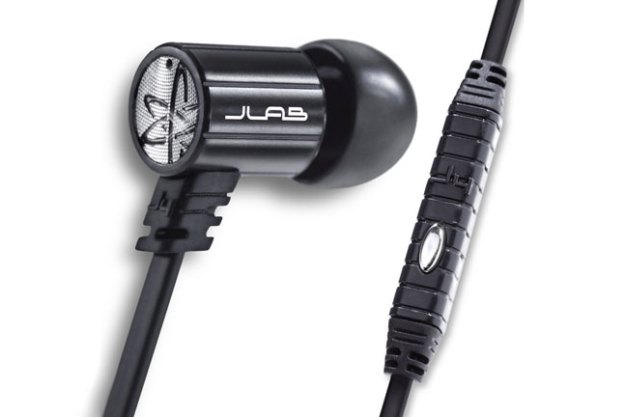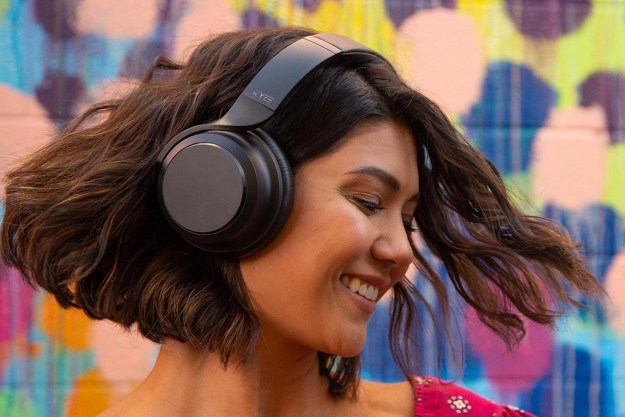
“The J4M get points for achieving a durable, rugged design and we appreciate the effort to provide a wide range of eartips for proper fit.”
- Rugged design
- Mic and control switch included
- Underwhelming sound
- Insecure fit
- No built-in volume control
Those looking to upgrade the stock earbuds that come with phones and portable media devices are now confronted with an almost ridiculous number of options. You can get some entry level ‘phones with the change in your pocket at the grocery store or pharmacy (ex: JVC Marshmallow) or for a few bucks more you can step it up a notch and grab a slightly more comfortable pair at the electronics department of your big-box store (ex: Sennheiser CX215).
Then there’s this segment that sits right around the $50.00 mark that, in our opinion, should start to offer better features and noticeably better sound quality than that of the entry-level bubble gum ilk. JLAB’s J4M JBuds, along with a slew of others we’ll be reviewing over the coming days fit right into that category. Let’s see how they stack up.
Out of the Box
One shouldn’t expect to be met with a bunch of extras when cracking open the box of a $50 set of earphones. You’re just not likely to get cord extensions, airline adapters or ¼” adapters at this level. The J4M don’t issue any surprises in this regard. What you do get is a pair of earphones and just about every eartip size under the sun. In total we counted four sizes of single flange silicone tips and three sizes of double flange tips. The J4M also come with a rugged, if not entirely attractive, carrying case that JLAB points out offers enough extra space to hold an iPod nano or shuffle as well.

Features
JLAB touts that the J4M may be the most rugged earphones ever made. We’re not sure we’d go that far, but we will concede that these earphones look and feel pretty tough. We’re not feeling gutsy enough to run them over with a car, but if we had to place a bet, our money would be on the J4M surviving the hit and run. It isn’t just the ear-pieces that feel tough, every contact point that the cord makes is reinforced by a thick, fairly flexible strain relief. Even the microphone and control unit located 4 inches down the left earphone cord is made of impact resistant plastic.
The J4M cord is flat and said to be tangle free. It may be tangle free, but it still gets twisted with the best of them. The cord is also a little on the stiff side, and as we’ll soon disclose, we think this contributed to a problem we had with the J4M popping out of our ears.


Performance
We tested the JRM using a Headroom Micro DAC, Headroom Micro Amp, and iPhone 3G, iPhone 4, and a Dell N5110 Laptop. Some of our test tracks included Marcus Miller’s “Panther” and “Mr. Pastorius” from the album The Sun Don’t Lie, “Uptown Up” and “Advanced Funk” from Maceo Parker’s Roots and Grooves” and “Babylon Sister” from Steely Dan’s Gaucho album.

We have to point to three factors that we believe caused the J4M to wiggle out of our ears. First, the rugged design, while great for keeping things from breaking, ends up placing weight in the wrong places. There’s enough ballast on the backside of the J4M that they tended to wanted to move out of our ears rather seat securely inside. Then there’s the issue of eartip texture. While soft, the eartips have no grip to them, so there’s little to keep them sliding against the skin. Finally, the stiffness of the cord that we mentioned earlier exerted enough force on the earphones as it moved around that there was no keeping the little buggers in place. Granted, everyone’s ears are different and we’re sure there are folks who haven’t had or won’t ever have problems keeping the J4M in place but, folks, we test a lot of earphones and we rarely have this problem. We’re pretty sure others will too.
In terms of sound quality, the J4M didn’t do a whole lot for us. There was some bloat around the mid-bass region, a noticeable bump right in the vocal region and some harshness around the sibilant sounds of the letter ‘s’. We can usually look around one audible oddity, but there was too much going on with the J4M for us not to say that we just didn’t enjoy their sound very much.
Conclusion
The J4M get points for achieving a durable, rugged design and we appreciate the effort to provide a wide range of eartips for proper fit. However, the lack of grip on the eartips along with heavy earphones and stiff cable made it tough to keep these earphones in place. That, along with sound quality with more than just a couple of quirks, keeps us from recommending the J4M.
Highs:
- Rugged design
- Mic and control switch included
Lows:
- Underwhelming sound
- Insecure fit
- No built-in volume control
Editors' Recommendations
- JLab steps closer to Sony and Bose with JBuds Lux ANC headphones
- JLab’s tiny JBuds Mini wireless earbuds are the smallest we’ve ever seen
- JLab JBuds Air Pro drop the price of BT Multipoint to $60
- Toshiba brings 120Hz to Fire TVs with new flagship M550-Series
- Sony says its new WF-1000XM4 earbuds set a new standard for noise cancellation




